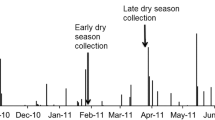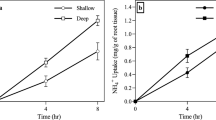Abstract
Explanations for the occurrence of deep-rooted plants in arid and semi-arid ecosystems have traditionally emphasized the uptake of relatively deep soil water. However, recent hydrologic data from arid systems show that soil water potentials at depth fluctuate little over long time periods, suggesting this water may be rarely utilized or replenished. In this study, we examine the distributions of root biomass, soil moisture and nutrient contents to 10-m depths at five semi-arid and arid sites across southwestern USA. We couple these depth distributions with strontium (Sr) isotope data that show deep (>1 m) nutrient uptake is prevalent at four of the five sites. At all of the sites, the highest abundance of one or more of the measured nutrients occurred deep within the soil profile, particularly for P, Ca2+ and Mg2+. Phosphate contents were greater at depth than in the top meter of soil at three of five sites. At Jornada, for example, the 2–3 m depth increment had twice the extractable P as the top meter of soil, despite the highest concentrations of P occurring at the surface. The prevalence of such deep resource pools, and our evidence for cation uptake from them, suggest nutrient uptake as a complementary explanation for the occurrence of deep-rooted plants in arid and semi-arid systems. We propose that hydraulic redistribution of shallow surface water to deep soil layers by roots may be the mechanism through which deep soil nutrients are mobilized and taken up by plants.





Similar content being viewed by others
References
Andraski BJ (1997) Soil-water movement under natural-site and waste-site conditions: a multiple-year field study in the Mojave Desert, Nevada. Water Resour Res 33:1901–1916
Burgess SSO, Adams MA, Turner NC, Ong CK (1998) The redistribution of soil water by tree root systems. Oecologia 115:306–311
Burgess SSO, Pate JS, Adams MA, Dawson TE (2000) Seasonal water acquisition and redistribution in the Australian woody phreatophyte, Banksia prionotes. Ann Bot 85:215–224
Burgess SSO, Adams MA, Turner NC, White DA, Ong CK (2001) Tree roots: conduits for deep recharge of soil water. Oecologia 126:158–165
Caldwell MM, Dawson TE, Richards JH (1998) Hydraulic lift: consequences of water efflux from the roots of plants. Oecologia 113:151–161
Canadell J, Jackson RB, Ehleringer JR, Mooney HA, Sala OE, Schulze ED (1996) Maximum rooting depth of vegetation types at the global scale. Oecologia 108:583–595
Capo RC, Stewart BW, Chadwick OA (1998) Strontium isotopes as tracers of ecosystem processes: theory and methods. Geoderma 82:197–225
Dawson TE (1993) Hydraulic lift and water use by plants: implications for water balance, performance and plant–plant interactions. Oecologia 95:565–574
Eissenstat DM, Caldwell MM (1988) Seasonal timing of root growth in favorable microsites. Ecology 69:870–873
Freckman DW, Virginia RA (1989) Plant-feeding nematodes in deep-rooting desert ecosystems. Ecology 70:1665–1678
Garten CT (1993) Variation in foliar 15N abundance and the availability of soil nitrogen on Walker Branch watershed. Ecology 74:2098–2113
Hultine KR, Williams DG, Burgess SSO, Keefer TO (2003) Contrasting patterns of hydraulic redistribution in three desert phreatophytes. Oecologia 135:167–175
Hultine KR, Scott RL, Cable WL, Goodrich DC, Williams DG (2004) Hydraulic redistribution by a dominant, warm-desert phreatophyte: seasonal patterns and response to precipitation pulses. Funct Ecol (in press)
Jackson RB, Manwaring JH, Caldwell MM (1990) Rapid physiological adjustment of roots to localized soil enrichment. Nature 344:58–60
Jackson RB, Moore LA, Hoffmann WH, Pockman WT, Linder CR (1999) Ecosystem rooting depth determined with caves and DNA. Proc Natl Acad Sci USA 96:11387–11392
Jackson RB, Schenk HJ, Jobbágy EG, Canadell J, Colello GD, Dickinson RE, Field CB, Friedlingstein P, Heimann M, Hibbard K, Kicklighter DW, Kleidon A, Neilson RP, Parton WJ, Sala OE, Sykes MT (2000) Belowground consequences of vegetation change and their treatment in models. Ecol Appl 10:470–483
Jackson RB, Sperry JS, Dawson TE (2000) Root water uptake and transport: using physiological processes in global predictions. Trends Plant Sci 5:482–488
Jackson RB, Banner JL, Jobbágy EG, Pockman WT, Wall DH (2002) Ecosystem carbon loss with woody plant invasion of grasslands. Nature 418:623–626
Jackson RB, Berthrong ST, Cook CW, Jobbágy EG, McCulley RL (2004) Comment on “A reservoir of nitrate beneath desert soils.” Science 304:51. DOI 10.1126/Science.109429
Jobbágy EG, Jackson RB (2001) The distribution of soil nutrients with depth: global patterns and the imprint of plants. Biogeochemistry 53:51–77
Koos WM, Williams JC, Dixon ML (1962) Soil survey of Wilbarger County, Texas. Series 1959, vol 18. USDA Soil Conservation Service
Ludwig F, Dawson TE, Kroon H, Berendse F, Prins HHT (2003) Hydraulic lift in Acacia tortilis trees on an East African savanna. Oecologia 134:293–300
Marschner H (1995) Mineral nutrition of higher plants. Academic, San Diego
Mooney HA, Gulmon SL, Rundel PW, Ehleringer JR (1980) Further observations on the water relations of Prosopis tamarugo of the Northern Atacama Desert. Oecologia 44:177–180
Moreira MZ, Scholz FG, Bucci SJ, Sternberg LS, Goldstein G, Meinzer FC, Franco AC (2003) Hydraulic lift in a neotropical savanna. Funct Ecol 17:573–581
Noy-Meir I (1973) Desert ecosystems: environment and producers. Annu Rev Ecol Syst 4:25–52
Nye PH, Tinker PB (1977) Solute movement in the soil–root system. University of California Press, Berkeley
Olsen SR, Sommers LE (1982) Phosphorus, Chap 24. In: Page AL (ed) Methods of soil analysis, Part 2: chemical and microbiological properties, 2nd edn. Soil Science Society of America, Madison, pp 403–430
Phillips FM (1994) Environmental tracers for water movement in desert soils of the American Southwest. Soil Sci Soc Am J 58:14–24
Poszwa A, Dambrine E, Ferry B, Pollier B, Loubet M (2002) Do deep tree roots provide nutrients to the tropical rainforest? Biogeochemistry 60:97–118
Rhoades JD (1982) Soluble salts, Chap 10. In: Page AL (ed) Methods of soil analysis, Part 2: chemical and microbiological properties, 2nd edn. Soil Science Society of America, Madison, pp 167–179
Richards JH, Caldwell MM (1987) Hydraulic lift: substantial nocturnal water transport between soil layers by Artemisia tridentata roots. Oecologia 73:486–489
Richter DD, Markewitz D (1995) How deep is soil? Bioscience 45:600–609
Rundel PW, Ehleringer JR, Nagy KA (1989) Stable isotopes in ecological research. Springer, Berlin Heidelberg New York
Ryel RJ, Caldwell MM, Yoder CK, Or D, Leffler AJ (2002) Hydraulic redistribution in a stand of Artemisia tridentata: evaluation of benefits to transpiration assessed with a simulation model. Oecologia 130:173–184
Ryel RJ, Caldwell MM, Leffler AJ, Yoder CK (2003) Rapid soil moisture recharge to depth by roots in a stand of Artemisia tridentata. Ecology 84:757–764
Scanlon BR (1991) Evaluation of moisture flux from chloride data in desert soils. J Hydrol 128:137–156
Scanlon BR, Tyler SW, Wierenga PJ (1997) Hydrologic issues in arid, unsaturated systems and implications for contaminant transport. Rev Geophys 35:461–490
Scanlon BR, Langford RP, Goldsmith RS (1999) Relationship between geomorphic settings and unsaturated flow in an arid setting. Water Resour Res 35:983–999
Schenk HJ, Jackson RB (2002) Rooting depths, lateral root spreads and below-ground/above-ground allometries of plants in water-limited ecosystems. J Ecol 90:480–494
Schulze ED, Mooney HA, Sala OE, Jobbagy E, Buchmann N, Bauer G, Canadell J, Jackson RB, Loreti J, Oesterheld M, Ehleringer JR (1996) Rooting depth, water availability, and vegetation cover along an aridity gradient in Patagonia. Oecologia 108:503–511
Seyfried MS, Murdock MD, Hanson CL, Flerchinger GN, Van Vactor SS (2001) Long-term soil water content database, Reynolds Creek Experimental Watershed, Idaho, USA. Water Resour Res 37:2847–2851
Seyfried MS, Schwinning S, Walvoord MA, Pockman WT, Newman BD, Jackson RB, Phillips FM (2005) Ecohydrological control of deep drainage in semiarid regions. Ecology (in press)
Silva S, Whitford WG, Jarrell WM, Virginia RA (1989) The microarthropod fauna associated with a deep rooted legume, Prosopis glandulosa, in the Chihuahuan desert. Biol Fertil Soils 7:330–335
Smith DM, Jackson NA, Roberts JM, Ong CK (1999) Reverse flow of sap in tree roots and downward siphoning of water by Grevillea robusta. Funct Ecol 13:256–264
Sposito G (1989) The chemistry of soils. Oxford University Press, New York
Suarez DL (1996) Beryllium, Magnesium, Calcium, Strontium, and Barium. In: Methods of soil analysis, Part 3: chemical methods. Soil Science Society of America, Madison
Thomas GW (1982) Exchangeable cations, Chap 9. In: Page AL (ed) Methods of soil analysis, Part 2: chemical and microbiological properties, 2nd edn. Soil Science Society of America, Madison, pp 159–165
Tyler SW, Walker GR (1994) Root zone effects on tracer migration in arid zones. Soil Sci Soc Am J 58:25–31
Van Auken OW (2000) Shrub invasions of North American semiarid grasslands. Annu Rev Ecol Syst 31:197–215
Vitousek PM, Kennedy MJ, Derry LA, Chadwick OA (1999) Weathering versus atmospheric sources of strontium in ecosystems on young volcanic soils. Oecologia 121:255–259
Walvoord MA, Plummer MA, Phillips FM, Wolfsberg AV (2002) Deep arid system hydrodynamics Part 1: equilibrium state and response times in thick desert vadose zones. Water Resour Res 38:1308
Walvoord MA, Phillips FM, Stonestrom DA, Evans RD, Hartsough PC, Newman BD, Striegl RG (2003) A reservoir of nitrate beneath desert soils. Science 302:1021–1024
Weaver JE, Albertson FW (1943) Resurvey of grasses, forbs, and underground plant parts at the end of the great drought. Ecol Monogr 13:63–117
Yaalon DH (1965) Downward movement and distribution of anions in soil profiles with limited wetting. In: Hallsworth EG, Crawford DV (eds) Experimental pedology. Butterworths, London
Yoder CK, Nowak RS (1999) Hydraulic lift among native plant species in the Mojave Desert. Plant Soil 215:93–102
Acknowledgements
This research was supported by the USDA and by the Biological and Environmental Research (BER) Program, US Department of Energy, through the Southcentral Regional Center of NIGEC. Additional funding came from a NSF CAREER grant and the Andrew W. Mellon Foundation. W.H. Schlesinger, D.D. Richter, and two anonymous reviewers provided helpful suggestions on the work presented here.
Author information
Authors and Affiliations
Corresponding author
Electronic Supplementary Material
Rights and permissions
About this article
Cite this article
McCulley, R.L., Jobbágy, E.G., Pockman, W.T. et al. Nutrient uptake as a contributing explanation for deep rooting in arid and semi-arid ecosystems. Oecologia 141, 620–628 (2004). https://doi.org/10.1007/s00442-004-1687-z
Received:
Accepted:
Published:
Issue Date:
DOI: https://doi.org/10.1007/s00442-004-1687-z




